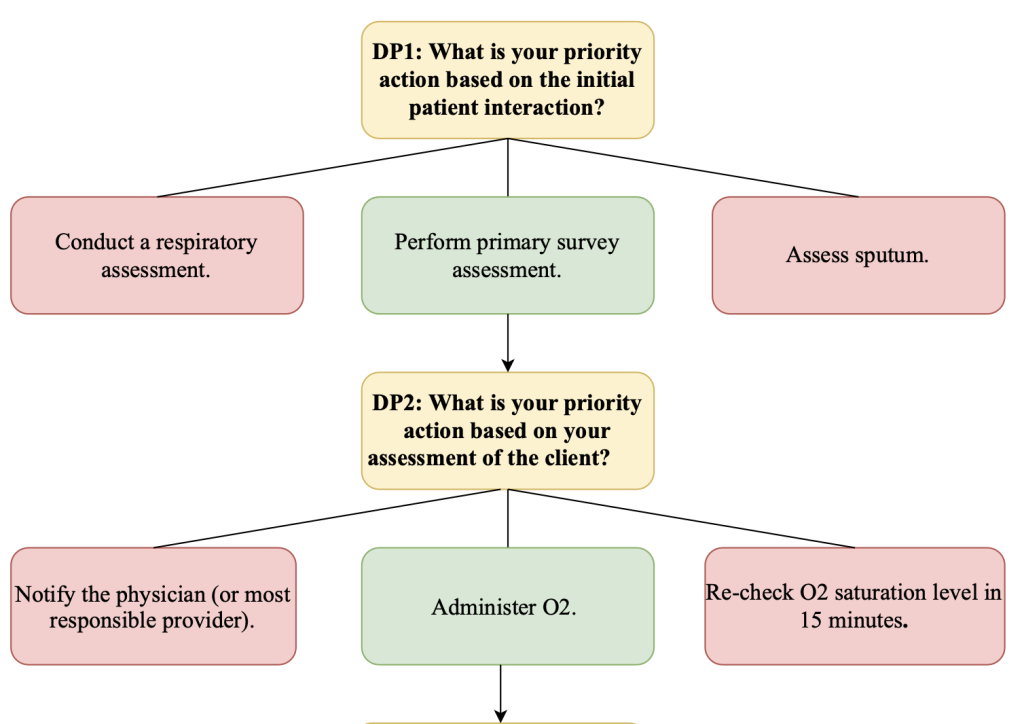Decision Point Questions, Options, and Feedback
Decision Point Questions
Decision point questions are questions that focus on the course learning outcomes and objectives, as well as the learner’s level. The decision point questions can help address gaps in the student’s knowledge and skills, highlight key course concepts, and address fears or concerns students may have or have experienced. Each learning outcome can be formatted into one or more decision point questions throughout the virtual gaming simulation.
Virtual Gaming Simulation (VGS) Model
Let’s practice creating some decision point questions!
The following description is based on a scene within the case scenario of the VGS Model.
Case Scenario Scene
The nurse enters the room and sees the client resting in a semi-Fowler’s position in bed. The nurse introduces themselves. The client tries to respond and has trouble speaking in full sentences and is short of breath. (Last set of vital signs are: RR 26, O2 Saturation 90% on room air, Temperature 37.9 degrees Celsius (oral), HR 100, BP 138/84). During the respiratory assessment, the nurse auscultates the lungs and hears an expiratory wheeze.
Based on Learning Outcome # 1: Demonstrate clinical judgement when assessing a client with acute COPD exacerbation, the following potential decision point questions can be created:
- What is your priority action based on your initial assessment?
- Connects to analyzing cues in the clinical judgement model.
- What are your respiratory assessment findings?
- Connects to recognizing cues in the clinical judgement model.
- What is your next action based on this XX cue?
- Connects to generating solutions in the clinical judgement model.

Each of the above VGS Model decision point questions are examples related to using clinical judgement when assessing a client with acute COPD exacerbation. It is important that you connect the virtual gaming simulation decision point questions to the learning outcomes, learning objectives and course content.
Ask Yourself – What decision point questions would facilitate students’ knowledge and skills required to successfully learn the course content?
The decision point questions should be written in second person terminology, therefore addressing the student directly and making them feel immersed within the storyline while playing the virtual simulation. Second-person narration encourages students to make decisions to determine what actions should occur next in the simulation. It encourages students to become engaged in the experience by being the nurse (main character) that provides care to the client in the scenario and enhances their accountability in the decision-making process.
Additional examples of decision point questions include:
- What is your priority assessment …?
- What communication strategy should you use to explore …?
- How should you respond to …?
- What additional information do you need to …?
- What intervention should you perform next …?
Decision Point Options
With each decision point question, you want to create a minimum of two to four options for the student to choose from. One option must be correct, and the other options could be based on common student errors or gaps in knowledge that they may experience in the course or during their practicum.
For example, with the VGS Model case scenario, the nurse enters the room and sees the client resting in a semi-Fowler’s position in bed. The nurse introduces themselves. The client tries to respond and has trouble speaking in full sentences and is short of breath. (Last set of vital signs are: RR 26, O2 Saturation 90% on room air, Temperature 37.9 degrees Celsius (oral), HR 100, BP 138/84). During the respiratory assessment, the nurse auscultates the lungs and hears an expiratory wheeze. The decision point question asks:
- What is your priority action based on your initial assessment?
This question can help facilitate students’ clinical judgement when conducting a primary survey assessment of the client’s presentation and situation. Many students will care for clients with shortness of breath and difficulty breathing. Students may feel uncomfortable responding to the client, especially for the first time, and may not know what to do or say to the client.
The options you create for the decision point question will depend on the student’s educational level and course content. For a second-year nursing student, you want to choose options that are at a second-year level and are commonly performed during their practicum.
Three potential options could include:
- Option 1: Provide reassurance.
- Option 2: Administer oxygen via mask.
- Option 3: Raise the head of the bed to high Fowler’s.
Each of the options is realistic and could occur in practice. However, not all of the options take priority when caring for a client with COPD who is short of breath and having trouble speaking in full sentences. Therefore, this example can support students’ knowledge and skills on what to do first when providing care for a similar client situation during their clinical practice.
Feedback
Each option should include feedback that relates back to the course content and learning outcomes. The purpose of the feedback is to encourage students to reflect on the decision they made and their current knowledge of the content and potential gaps in their knowledge. The feedback should refer students back to course content, or best practice guidelines/protocols/competencies related to the student’s discipline. Kolb’s (1984) experiential learning cycle supports the importance of reflection in learning and is often used when designing virtual gaming simulations.
If the student chooses the incorrect option, provide feedback to encourage the student to reflect on their decision. Link the feedback to the course content to foster the student’s self-directed learning. Feedback can provide the student an opportunity to reflect on their knowledge, identify potential learning gaps, and seek out additional information as needed in their learning process. After the feedback, the game should redirect the student back to the decision point question and provide them with another opportunity to choose the correct option.
For the above option examples, potential feedback could include:
- Provide reassurance.
- Feedback: Providing reassurance does not address the client’s shortness of breath and trouble speaking in full sentences. Reflect on how to assist the client to breathe more effectively. What priority action based on your initial assessment should you perform?
- Administer oxygen via mask.
- Feedback: Oxygen can assist with the client’s respiratory efforts. Reflect on the client’s position and respiratory status. What priority action based on your initial assessment should you perform?
- Raise the head of the bed to high Fowler’s.
- Feedback: Correct! This is the priority action. Raising the head of the bed will promote lung expansion thereby saving energy when breathing, increasing comfort when breathing, and minimizes respiratory effort.
Each of the above feedback examples is linked back to the decision point question related to the learning outcome on demonstrating clinical judgment when assessing a client with COPD exacerbation. It also focuses on second-year nursing course content and clinical expectations.
Student Voices
“I feel like the virtual simulation is so life like, it gives a sense of actually 
caring for real people, but through a screen. The scenarios are real life scenarios, and if you get something wrong the feedback explains how that decision affected the client.”
~ Olivia Shariff, 1st year nursing student
Additional Resources
For more examples of decision point questions, options, and feedback, you can review the summary page of the Health History Interview Virtual Gaming Simulation. This virtual gaming simulation’s decision point questions are video and images. Whereas the Interprofessional Virtual Gaming Simulation: Breaking the Chain of Transmission has a combination of videos, images, and interactive H5P questions, including feedback, to assess the learner’s knowledge.
Reference
Kolb, D. A. (1984). Experiential learning: Experience as the source of learning and development (Vol. 1). Englewood Cliffs, NJ: Prentice-Hall.

